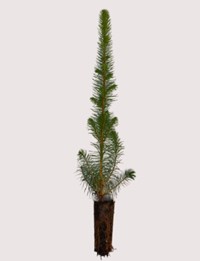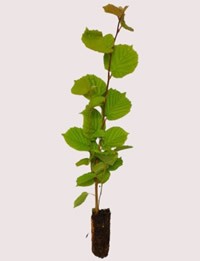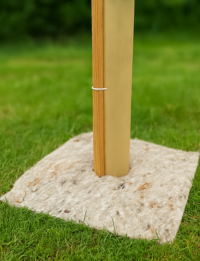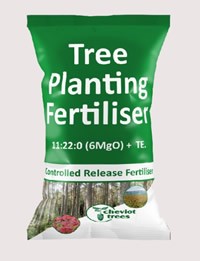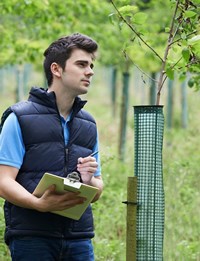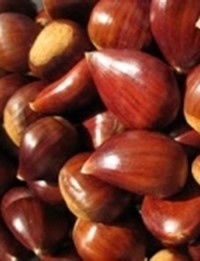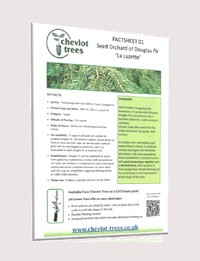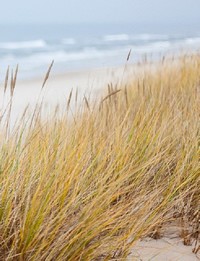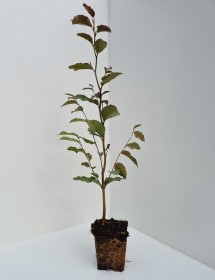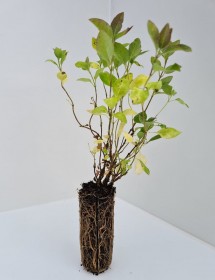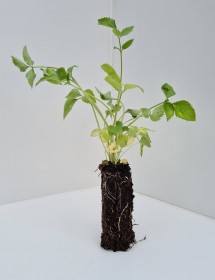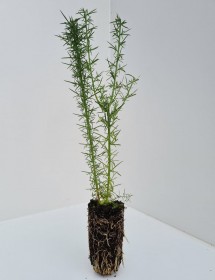
Shrubs

At Cheviot Trees we grow large quantities of cell grown woody shrubs to complement our other ranges of trees and hedging on planting sites.
We grow species to suit all planting objectives including woodland underplanting, game cover, screening and hedging
-
Buxus sempervirens - Box
£2.13from £1.28The majority of the Buxus sempervirens - Box plants that we supply are used for hedging as it makes a fabulous formal hedge, but our clients also use it for planting as an understorey species in mixed woodlands or for game cover.
Evergreen with small, shiny dark green leaves. It is a very long lived species and can live for several hundred years.
-
Calluna vulgaris - Native Wild Heather
£1.82from £0.81Calluna vulgaris - Native Wild Heather is the dominant heath plant in many parts of the UK. It has a wide range and is widely distributed throughout Europe as far North as the Faroe Islands.
Mauve pink flowers bloom from July to September which create a colourful scene in the countryside.
Native heather is an important source of food for butterflies and bees with hives often located on heather moorland in the Summer where the bees can easily obtain the nectar from the heather flowers to produce a very distinctive and much sought after ‘heather honey’.
The majority of the plants that we supply are used for heathland restoration projects in the countryside or on golf courses.
-
Cornus alba - Red Dogwood
£1.52from £0.67Cornus alba - Red Dogwood is a shrub that grows well in wet soils and is normally found along woodland edges and in hedgerows. It is a good choice for game cover.
Red Dogwood is grown mainly for its bright red stems. Deciduous with fresh green leaves that have distinctive curved veins. The leaves turn a rich crimson colour in the Autumn.
Creamy white flowers are produced in clusters which once pollinated by insects develop into small black berries which are eaten by birds and mammals.
Our cell grown Cornus alba - Red Dogwood plants are often used for hedge planting either on their own or mixed with other species such as Hawthorn, Blackthorn, Dog rose etc. at a planting density of 6 plants per metre.
-
Cornus sanguinea - Common Dogwood
£1.52from £0.67Cornus sanguinea - Common Dogwood is a native shrub that grows well is wet soils and is normally found along woodland edges and in hedgerows. It is a good choice for game cover.
Deciduous with fresh green leaves that have distinctive curved veins. The leaves turn a rich crimson colour in the Autumn.
Creamy white flowers are produced in clusters which once pollinated by insects develop into small black berries which are eaten by birds and mammals.
Our cell grown Dogwood plants are often used for hedge planting either on their own or mixed with other species such as Hawthorn, Blackthorn, Dog rose etc at a planting density of 6 plants per metre.
-
Cotoneaster lacteus - Milkflower Cotoneaster
£1.93from £0.93Cotoneaster lacteus - Milkflower Cotoneaster is a dense evergreen shrub that can be used for an informal hedge or screen.
Its main attraction is the clusters of creamy white flowers which persist all summer and then masses of red berries are produced in the autumn and stay on the plant until the winter.
This species has a wide arching habit with large leathery leaves with deep veins which have a furry underside.
-
Cytisus scoparius - Broom
£1.98from £0.88Cytisus scoparius - Broom is a large, native shrub that is often found on heathland, woodland and coastal areas.
It thrives in poor soil and is a useful plant for stablising soil.
It produces bright yellow flowers in the Spring which smell of vanilla. The flowers then ripen into seed pods which crack open in the Summer.
There are many different varieties of Broom but we produce the native type from seed.
-
Empetrum nigrum - Crowberry
£1.93from £0.93Cheviot Trees are specialist producers of native moorland plants such as Empetrum nigrum - Crowberry.
A mat forming shrub with tiny purple, stalkless starry flowers that have stubby, needle like leaves. The fruit is a shiny black berry which is initially green, then turning pink, purple and finally black.
Often bound growing in acidic soils in shady, wet areas. Found on moors, bogs and wet slopes.
-
Erica tetralix - Cross leaved Heath
£1.93from £0.93The cross leaved heath is native to the UK and is often found on heathland and moors.
Shrubby in habit, it produces small pink bell shaped flowers that are produced in clusters at the end of its shoots. Narrow grey-green leaves which are arranged in fours around the stem, hence the name.
-
Eucalyptus dalrympleana - Mountain Gum
£2.13from £1.03Eucalyptus dalrympleana - Mountain Gum is one of the most popular species of Eucalypts grown in the UK due to its cold tolerance properties. A fast growing species which is very productive and adaptable to many purposes including biomass production, firewood, screening and foliage production.
Evergreen with ovate foliage which is copper tinged in colour when juvenile, turning blue/ green. Like most Eucalypts, the bark is often equally as impressive as the foliage and this species does not disappoint with shades of white and grey.
-
Euonymus europeaus - Spindle
£1.84from £0.89Spindle hedging plants provide a wonderful array of autumn colour. The four-lobed capsules burst into life with a vibrant shade of pink, opening to reveal orange fruits in the autumn. Euonymus europaeus hedging plants have dark green foliage that transforms into rich shades of red and yellow in autumn, adding another layer of colour to your garden. Spindle produces a dense hard wood that was traditionally used for making spindles and small implements.
A fast-growing species, Spindle is ideal for giving an array of colour to a hedge and is an excellent attractor of wildlife.
-
Fagus sylvatica atropurpurea - Copper Beech
£3.64from £2.18Fagus sylvatica atropurpurea - Copper Beech is a vibrant and stunning variety of Beech that forms a very large specimen tree in a parkland setting. Very eye catching and perfectly suited for hedge planting either on its own or mixed with Green Beech.
Smooth, silver grey bark. Deep purple leaves in the Spring and Summer turning yellow then copper in autumn. The leaves are retained on the plant during the winter if the plant is maintained as a hedge. If you are comparing Beech or Hornbeam for hedging and you have damp soil and or you are in a cold exposed area then we would suggest using Hornbeam.
-
Ilex aquifolium - Holly
£3.34from £1.47A classic, native evergreen hedging plant, Ilex aquifolium - Holly growth rate is fairly slow at about 10-20cm a year, but what these hedging plants lack in speed, they make up for with seasonal interest and colourful foliage.
As a native hedging plant, Ilex is great for providing food and shelter to British wildlife. Birds such as blackbirds, chaffinches, robins and waxwings feast on the bright red berries and Holly plants provide a good source of nectar and pollen for bees. Holly hedging is the most beneficial to wildlife when left to grow naturally, as the bushy habit provides a safe, protected habitat
-
Juglans nigra - Black Walnut
£3.64from £1.73Juglans nigra - Black Walnut is a large fast growing species. We primarily grow this species for our forestry customers as the timber is highly valued, but it is also worth considering for its ornamental attributes.
Introduced to the UK from North America some 400 years ago, Black Walnut has a lot to offer.
The timber of Black Walnut is heavy, strong and durable with a value of 3-4 times that of Oak.
The foliage is pinnate with individual oval pointed leaflets which turn yellow in autumn.
Flowers appear in early Summer in the form of long catkins and in the Autumn the flowers turn to brownish green fruits that are around the size of a plum. The brown nut is held inside the husk.
We also produce Juglans regia - Common Walnut.
-
Ligustrum ovalifolium - Oval Leaved Privet
£1.93from £0.93Ligustrum ovalifolium – Oval leaf privet is a fast growing semi evergreen hedging species with glossy dark green leaves and creamy white flowers during the summer months.
A robust species which tolerates regular pruning. Also suitable for coastal locations although you may notice some defoliation during winter.
You may also wish to consider Wild Privet which has narrower leaves and a looser growing habit.
Creamy white flowers during the summer months.
-
Ligustrum vulgare - Wild Privet
£1.98from £1.22Ligustrum vulgare - Wild Privet is a bushy, native shrub that we often supply as part of a native hedge mixture but it is also useful on the edge of woodlands or as game cover due to its good tolerance of shade.
It is semi evergreen so provides useful cover and shelter for wildlife in the winter thanks to its relatively untidy and gnarly habit.
Semi evergreen with thin, green pointed leaves. Small white flowers are produced in the Summer with dark purple berries that follow in the Autumn.
You may also wish to consider Oval Leaf Privet which has larger oval leaves with better retention properties.
-
Lonicera nitida - Boxleaf Honeysuckle
£3.34from £1.47Lonicera nitida, commonly known as the Boxleaf Honeysuckle due to its small box type leaf that is pale green in colour.
It has as looser habit when compared against box so it should not be first choice for formal hedging but it is useful for planting on woodland edges as it offers good winter shelter and interest.
Fast growing and evergreen with small white flowers appearing in Spring.
-
Lonicera periclymenum - Honeysuckle
£3.34from £2.01Lonicera periclymenum - Honeysuckle is useful addition to a native hedgerow as it can easily scramble its way through the hedge, knitting everything together.
Deciduous. The main interest beings is the trumpet like flowers which attract wildlife in their masses. The flowers are sweet in fragrance are rich in nectar and are particularly attractive to moths.
Berries follow in the autumn which are eaten by birds who also use the dense branches as nesting sites.
You don’t need many Honeysuckle in a hedge to make an impact. A ration fo around 5% of your total mixture is more than sufficient.
-
Prunus laurocerasus - Cherry Laurel
£1.92from £0.93Prunus laurocerasus - Cherry Laurel is one of the most popular hedging plants in our range.
Fast growing, tolerant and easy to grow it is a superb choice if you need a solid screen. We also grow Portuguese Laurel which has a smaller more pointed leaf.
Cherry laurel does produce flowers and berries although these are quite insignificant as the main attraction is the large, dark green glossy leaves.
Its good tolerance of shade also makes it suitable for planting in open areas of woodland or on edges if shelter or cover is required.
3 plants per linear metre in a single row is normally sufficient to create a dense screen in time.
-
Prunus lusitanica - Portuguese Laurel
£2.13from £1.03Prunus lusitanica - Portuguese Laurel has all the desirable properties of Cherry Laurel but has a smaller, pointed leaf.
Fast growing, tolerant and easy to grow it is a superb choice if you need a solid screen. It responds well to clipping and if desired, it is possible to achieve a very tight, formal hedge, more so than the Cherry Laurel - Prunus laurocerasus.
It does produce flowers and berries although these are quite insignificant as the main attraction is the large, dark green glossy leaves.
Its good tolerance of shade also makes it suitable for planting in open areas of woodland or on edges if shelter or cover is required.
3 plants per linear metre in a single row is normally sufficient to create a dense screen in time.
-
Rhamanus cathartica - Purging Buckthorn
£1.93from £0.93Rhamanus cathartica – Purging Buckthorn is a native small tree / large dense shrub with grey-brown bark and spiny branches.
Flowers are yellow green with four petals and are pollinated by insects. After pollination, the female flowers develop into black berries
Useful for woodland planting or hedging. The leaves of Purging Buckthorn are an important food source for tiger moth larvae and caterpillars of the Brimstone butterfly.
-
Rhamnus frangula - Alder Buckthorn
£1.93from £0.93Rhamanus frangula – Alder Buckthorn is a native small tree / large dense shrub
The outer bark is dark brown and unlike the Purging Buckthorn, the branches and stems are smooth and thornless. Star shaped flowers in the Spring with red berries following which then mature / darken to almost black in the Autumn.
Native to the UK and grows best in damp, acidic soils and open woods.
Useful for woodland planting or hedging. The leaves of Alder Buckthorn are an important food source for tiger moth larvae and caterpillars of the Brimstone butterfly.
-
Rosa canina - Dog Rose (Pink)
£1.52from £0.67Rosa canina - Dog Rose is the only native Rose that we produce, and it is the most widely used as it is easy to grow and is adaptable to most locations.
Ideal for planting as part of a native mixture or on its own.
Deciduous with small green toothed leaves. Large and sweetly scented white or pink flowers appear in summer with red oval berry like hips forming in small clusters.
Dog Rose is a good choice for wildlife, offering protective shelter and habitat plus a good source of nectar for insects. Bird species such as blackbirds, redwings and waxwings eat the hips.
-
Rosa rugosa Alba - Ramanas Rose (White)
£1.93from £0.93Rosa rugosa Alba - Ramanas Rose is a large robust shrub that produces large, beautiful and very fragrant bowl shaped flower that are silky white. It flowers earlier than our native Dog Rose and often repeat flowers during the Spring and Summer. Very large, red hips follow the flowers.
The stems are covered in small spines which makes it ideal for an impenetrable and dense hedge or barrier.
A good all rounder. Attractive, good disease resistance, fast growing and very tolerant of exposure and coastal locations.
We also produce Rosa rugosa which has fuchsia pink flowers.
-
Rosa rugosa - Ramanas Rose (Pink)
£1.93from £0.93Rosa rugosa - Ramanas Rose is a large robust shrub that produces large, beautiful and very fragrant bowl shaped flower that are fuchsia pink in colour. It flowers earlier than our native Dog Rose and often repeat flowers during the Spring and Summer. Very large red hips follow the flowers.
The stems are covered in small spines which makes it ideal for an impenetrable and dense hedge or barrier.
A good all rounder. Attractive, good disease resistance, fast growing and very tolerant of exposure and coastal locations.
We also produce Rosa rugosa alba which has silky white flowers.
-
Sambucus nigra - Elder
£1.82from £0.81Sambucus nigra - Elder is a large, fast growing native species that is best planted as a woodland shrub. It is often found in hedgerows but it is often too thuggish for this purpose.
Green, pinnate leaves with oval and toothed leaflets.
The flowers are the main attraction with Elder; they are large and flat in a cluster like form, cream in colour and are highly scented. They provide nectar for insects and the base for a quintessentially British cordial!
After the flowers are pollinated by insects each flower develops into a small purplish black berry which ripens from late summer and are eaten by small mammals.
-
Symphoricarpos albus - Snowberry
£1.93from £0.93Symphoricarpos albus - Snowberry is a dense shrub that is fast growing and very tolerant of shade and poor soils.
It is often used for screening and is often favoured by game birds as it provides shelter and security.
Deciduous with light green leaves. Small pink flowers in July that turn to pearl white berries in the Autumn.
-
Ulex europeaus - Gorse
£1.98from £0.88Ulex europeaus - Gorse is tough, adaptable and very pretty when planted en mass The ‘leaves’ are long sharp spikes that are hostile in appearance.
The vibrant, coconut scented yellow flowers symbolise that spring has arrived and typically appear in April/May.
Many species of birds take full advantage of the dense shelter that gorse provides and the gorse flowers are a great source of nectar for bees and butterflies.
-
Viburnum opulus - Guelder Rose
£2.13from £1.03Viburnum opulus - Guelder Rose is a large shrub with three lobed leaves which turn orange or red in autumn. Enjoys damp conditions and is often found along riverbanks, but also in hedgerows.
The flowers of Viburnum opulus appear in May through July and produces small clusters of almost translucent red berries in the autumn.


